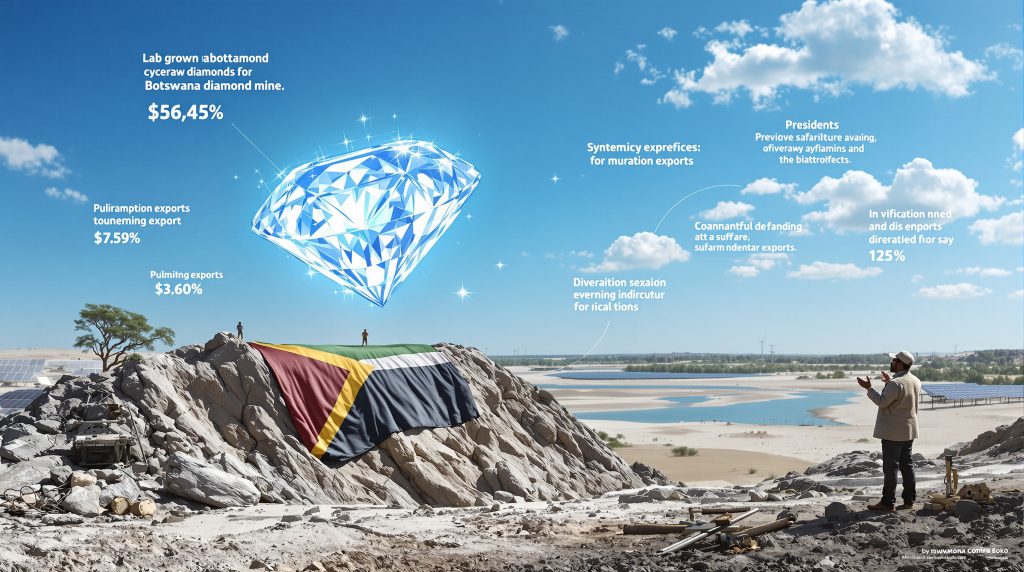The Diamond Dependency Crisis: How Lab-Grown Gems Are Reshaping Botswana's Economy
Botswana's economic landscape is undergoing a seismic shift as lab-grown diamonds in Botswana increasingly capture market share from natural diamonds, threatening the foundation of what was once Africa's most celebrated economic success story. This nation of 2.5 million people transformed from an impoverished backwater at independence in 1966 to a middle-income country, largely on the strength of diamond wealth discovered in 1967. Today, that once-reliable foundation faces unprecedented challenges.
The Scale of Botswana's Diamond Dependence
The extent of Botswana's reliance on diamond mining is difficult to overstate:
- Diamonds represent approximately 80% of the country's export earnings
- They provide one-third of government revenue
- The sector contributes roughly 30% of GDP
This extreme concentration in a single industry has left Botswana particularly vulnerable to market disruptions. When diamonds thrived, so did Botswana, allowing it to invest in infrastructure, healthcare, and education at levels that made it the envy of southern Africa. However, this dependency is now revealing its dangers as global diamond markets evolve.
Why Are Lab-Grown Diamonds Gaining Momentum?
The synthetic diamond revolution represents perhaps the most significant disruption to the natural diamond industry since the discovery of alluvial diamonds on Namibia's beaches in the early 20th century, which temporarily collapsed diamond prices. Similar challenges are now affecting uranium mining in Namibia as resource markets face technological disruption.
The Technological Revolution in Diamond Production
Lab-grown diamonds in Botswana are chemically, physically, and optically identical to natural diamonds but can be produced in weeks rather than the billions of years required for natural formation. These synthetic gems are created through two primary methods:
- High Pressure-High Temperature (HPHT): Replicating the natural conditions under which diamonds form
- Chemical Vapor Deposition (CVD): Growing diamonds layer by layer from a hydrocarbon gas mixture
This technological advancement has transformed market fundamentals in several critical ways:
- Production costs have fallen dramatically (now under $400 per carat for many sizes)
- Manufacturing capacity has expanded exponentially, particularly in China and India
- Price differentials are impossible for consumers to ignore (80-90% less expensive than natural equivalents)
Consumer Preference Shifts
The American market, which accounts for nearly half of global diamond jewelry sales, has witnessed a remarkable shift in consumer behavior:
- Lab-grown diamonds accounted for nearly 50% of engagement ring purchases in 2024
- This represents a tenfold increase from just 5% in 2019
- The 25-35 age demographic shows particularly strong preference for lab-grown options
Price advantage is certainly a factor, but ethical positioning also plays a significant role. Many younger consumers cite concerns about environmental impact and labor practices in traditional diamond mining, though industry experts note that both natural and lab-grown sectors face sustainability transformation challenges.
What Economic Impacts Is Botswana Experiencing?
The effects of this market disruption are rippling through Botswana's economy, creating fiscal challenges that threaten the country's development model.
Government Budget Crisis
The fiscal situation has deteriorated with alarming speed:
- The IMF forecasts an 11% budget deficit for 2025 – the largest in sub-Saharan Africa
- Government debt is projected to double in just two years, reaching 43% of GDP
- Foreign reserves have plummeted by 27% over the past year
- The finance ministry has abandoned its forecast of 3.3% growth for 2025, now projecting a 0.4% economic contraction
These figures represent a dramatic reversal for a country that historically maintained prudent fiscal management and substantial reserves through its Pula Fund sovereign wealth mechanism.
Healthcare System Under Strain
Botswana's healthcare system, once a model for the region with its free and accessible services, now faces severe challenges:
- Medication shortages have become increasingly common
- Patient wait times have extended dramatically – some now wait up to eight hours for services that previously took one hour
- In August 2025, President Duma Boko declared a public health emergency
Diabetes patient Galeemiswe Mosheti exemplifies the human impact of these changes. The 42-year-old taxi driver now spends up to eight hours waiting for medicine at government clinics, compared to just one hour previously – time away that directly impacts his income and livelihood.
Education Funding Challenges
The educational infrastructure that helped build Botswana's human capital is also feeling the pressure:
- University students have threatened boycotts over promised allowance increases that failed to materialize
- Scholarship programs for overseas study have been curtailed
- Educational infrastructure investments have been delayed indefinitely
- Government recruitment freezes have affected staffing across the education sector
How Is the Diamond Industry Responding?
The traditional diamond industry is undergoing significant operational and structural changes in response to these market pressures, mirroring broader mining industry evolution trends.
Production Cuts and Operational Changes
Debswana, the joint venture between the Botswana government and De Beers that produces nearly all of the country's diamonds, has implemented dramatic adjustments:
- Production reduced to approximately 15 million carats in 2025 (40% lower than 2023 levels)
- Operations running at roughly 60% of capacity
- Temporary halts at major mining operations
These production cuts reflect a fundamental shift in strategy – from maximizing output to managing supply in hopes of stabilizing prices.
Corporate Restructuring
The industry is experiencing significant corporate changes that would have been unthinkable a decade ago:
- Anglo American has written down the value of De Beers multiple times
- The company is actively seeking to sell its stake in the world's largest diamond producer
- This potential sale represents a seismic shift in the industry's structure
Industry insiders note that these changes reflect a recognition that the diamond market has fundamentally changed, rather than simply experiencing a cyclical downturn. This follows broader industry consolidation trends seen across global mining.
What Diversification Efforts Are Underway?
Faced with this crisis, Botswana is accelerating long-discussed economic diversification efforts.
Tourism Development
The government is intensifying focus on the tourism sector:
- Luxury safari experiences in the Okavango Delta
- Wildlife conservation initiatives highlighting the world's largest elephant population
- Infrastructure improvements to increase accessibility
However, tourism currently accounts for only 12% of GDP, making it a promising but insufficient replacement for diamond revenues in the near term.
Renewable Energy Investments
President Boko has identified renewable energy as a potential growth sector:
- Solar power development leveraging the country's abundant sunshine
- Regional energy export opportunities to neighboring countries
- Technology transfer and skills development programs
Botswana's geographic positioning and natural resources provide advantages in this sector, though building the necessary infrastructure requires significant capital that is increasingly scarce.
Agricultural Modernization
Agricultural development is receiving renewed attention:
- Irrigation projects to overcome the arid climate
- Value-added processing facilities to create manufacturing jobs
- Export market development for specialty products
In July 2025, the government engaged Malaysia's PEMANDU Associates to advise on accelerating economic diversification, signaling a recognition that external expertise might help speed the transition. The country is also exploring mineral beneficiation opportunities to add value to remaining natural resources.
What Are the Long-Term Prospects for Botswana?
The path forward for Botswana involves navigating both immediate challenges and long-term structural transitions.
Market Reality Check
Industry analysts are increasingly pessimistic about a natural diamond market recovery:
- Unlike cyclical commodities like oil, diamond prices are unlikely to rebound significantly
- Lab-grown production capacity continues to expand, particularly in China
- Consumer preference shifts appear to be structural rather than temporary
- Natural diamond marketing has struggled to establish sufficient value differentiation
This assessment suggests that Botswana must plan for a future with permanently lower diamond revenues rather than waiting for a market rebound.
Economic Transformation Challenges
The path to economic diversification faces significant hurdles:
- Limited infrastructure beyond the diamond sector
- High youth unemployment (over 40% for those under 24)
- Geographical challenges including landlocked status and arid climate
- Competition from more established economies in potential growth sectors
Social Stability Concerns
The social contract in Botswana has been built on diamond wealth redistribution:
- Free healthcare and education have been hallmarks of the system
- Rising unemployment threatens social cohesion
- The political transition in 2024 (ending decades of single-party rule) adds uncertainty
President Boko's administration, which in October 2024 displaced a political party that had ruled since independence, faces the challenge of managing this transition while maintaining social stability.
What Can Other Resource-Dependent Economies Learn?
Botswana's experience offers valuable lessons for other nations dependent on a single commodity or resource, as detailed by the World Politics Review.
Diversification Imperatives
The critical takeaways include:
- Economic concentration creates vulnerability to technological disruption
- Diversification efforts must begin during resource booms, not after declines
- Building human capital and infrastructure should take precedence over consumption
- Technology can disrupt commodity markets more rapidly than historical patterns suggest
Sovereign Wealth Management
Financial management strategies matter significantly:
- Botswana's Pula Fund provided some buffer against the initial shock
- However, the scale of the diamond market collapse overwhelmed these reserves
- More aggressive diversification of national assets into global investments may be necessary
- Counter-cyclical investment strategies are essential for resource-dependent economies
Beyond the Diamond Crisis
While the challenges are significant, Botswana retains important advantages that could facilitate a successful economic transition, as reported by Bloomberg.
Institutional Strength
The country maintains several key assets:
- Strong democratic institutions and rule of law
- Relatively low corruption compared to regional peers
- History of prudent macroeconomic management
- Well-educated workforce relative to its development stage
These institutional strengths provide a foundation that many other resource-dependent economies lack when facing similar transitions.
Regional Integration Opportunities
Botswana could leverage its position within southern Africa:
- Potential logistical hub connecting South Africa with countries to the north
- Regional financial services development
- Cross-border infrastructure projects
Cautious Optimism on Foreign Investment
In August 2025, President Boko announced a plan for Qatar's Al Mansour Holdings to invest $12 billion in Botswana. While such investments could accelerate diversification, analysts note that similar promises across multiple African countries raise questions about the credibility of such pledges.
Conclusion: Navigating the Post-Diamond Future
Botswana stands at a critical juncture as lab-grown diamonds in Botswana fundamentally alter the economic landscape that has supported the nation for generations. The country that once represented Africa's development success story now faces the challenge of reinventing its economy under pressure.
The coming years will determine whether Botswana can successfully navigate this transition or become a cautionary tale of resource dependency in an era of rapid technological change. The stakes extend beyond economics to the social fabric and development model that have defined modern Botswana.
For other resource-dependent economies, Botswana's experience highlights the urgency of diversification before crisis strikes. Technological disruption can fundamentally alter commodity markets with startling speed, making yesterday's dependable resource into today's economic liability.
Note: This article represents the situation as of September 2025. Economic conditions and industry developments may have changed since publication.
Are You Interested in ASX Mining Investment Opportunities?
Discover real-time alerts on significant ASX mineral discoveries, powered by the proprietary Discovery IQ model that transforms complex mineral data into actionable investment insights. Visit the Discovery Alert discoveries page to understand how major mineral discoveries can lead to substantial market returns and begin your 30-day free trial today.




